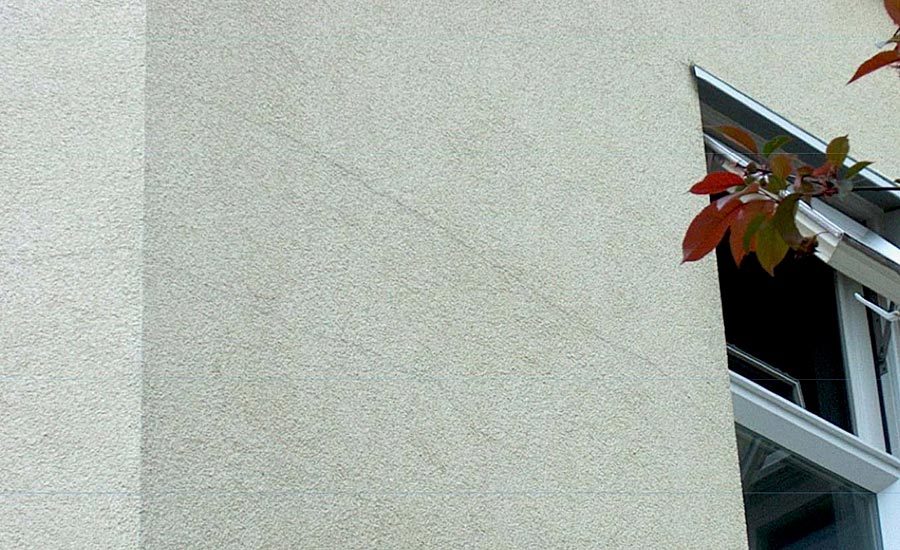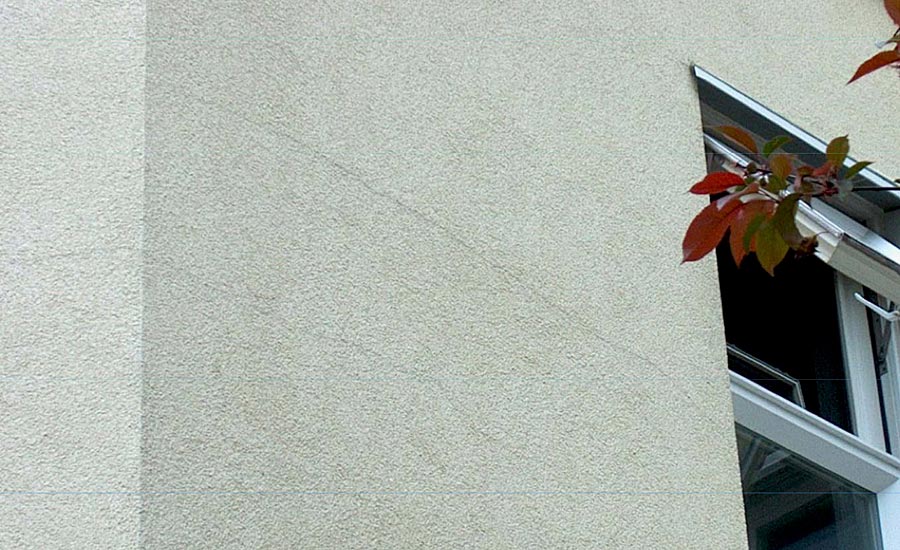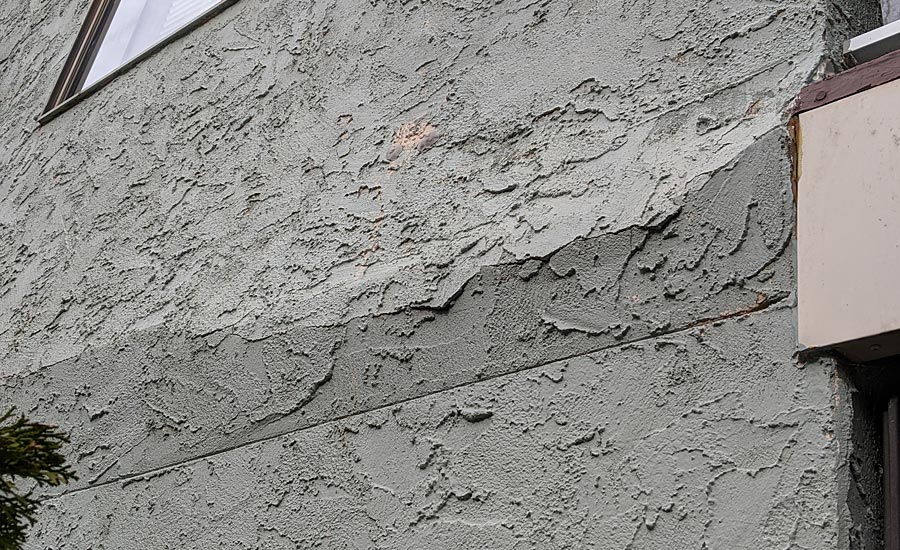Improving Stucco Performance
THE BETTER UNDERSTANDING OF STUCCO, THE BETTER STUCCO INSTALLATION.








Stucco has successfully been used for centuries and provides a resilient, unified look for residential and commercial facades. The variety of stucco finishes can complement both traditional and contemporary styles. Moreover, stucco is cost-effective as compared to various exterior coatings, it may be applied at a rapid rate and is extremely durable. Stucco has the lowest annual maintenance cost when compared to other claddings.
Stucco is a cementitious material so cracking can occur under certain conditions. Cracking presents aesthetic as well as water entry concerns. It is impossible to eliminate cracking entirely, but understanding what impacts stucco walls will lead to better stucco installations.
Stucco, similar to concrete, is very strong in compression but weak in tension. Stucco compression strengths range from 2000 to 3000 psi, but tensile strength is only 100 to 200 psi. Because of this, lathing is required which serves two functions: it provides a mechanical attachment path from the stucco to the structure and it provides reinforcement to the stucco to provide tensile strength, similar to reinforced concrete. All laths provide good reinforcing strength in the horizontal direction, but are weaker in the vertical direction. Some lath types are weaker than others in this direction, providing less reinforcing strength. Therefore, it is not uncommon to see linear horizontal cracking on stucco.
How to Minimize Stucco Cracking
Stucco will crack when the imposed tensile stresses exceed the tensile strength of the stucco and lath combination. Tensile stresses are caused primarily by shrinkage of the stucco during the curing process. Shrinkage of stucco has been studied over the years and is well documented.
Hence the need to follow good work practices to minimize the stresses on the stucco and minimize cracking potential. Here are some of those fundamental factors:
• Proper mix and application: good quality, properly sized, clean sand is essential for quality stucco. Sand to cementitious ratios need to be maintained per ASTM C926. Remember that these are volumetric ratios, and that the lime counts as part of the cement portion. The scratch coat needs to be the richest cementitious mix, followed by weaker brown coat, and then the finish coat being the weakest.
• Moist curing: good moist curing is critical to minimize shrinkage and to achieve harder, stronger stucco, especially in hot windy conditions. Stucco should be kept moist for a minimum of 48 hours. Fine water spray should be applied in morning and evening. This continued moisture allows the hydration of the Portland cement to continue and for the stucco to achieve the desired strength. Additional moist curing may be required depending on wind, temperature, and humidity conditions.
• Wood based sheathing: plywood expands 0.0002 in/in for each 10 percent change in humidity. Doesn’t sound like much? Let’s say we have a 60 foot wall and 20 percent humidity change—the expansion of the sheathing would be 0.3 inches. As a result, there would be increased force imposed on the stucco and the stucco would have to crack. This is why there is the requirement to provide a 1/8-inch gap between sheets of wood-based sheathing. If the framer hasn’t provided the gapping, then the lather (presuming he is putting up the WRB) must ensure it is done before the WRB goes on.
• Consistent stucco thickness is required to distribute the stress equally. Thin sections create stress where cracks can occur. We see stucco thickness variations frequently on open framing systems where the stone wire and paper are not applied tightly, and thinner stucco sections end up over the stud locations. The cracks then generally occur over the stud locations, and in a wall, end up not hidden but exposed.
• Control joints: provide stress relief and their installation and effectiveness are a subject of controversy. Our ASTM standards require that control joints be installed to create areas no larger than 144 sq. feet and that lath be cut at those joints allowing the stucco to release stress.
• Water entry and humidity change can impact stucco walls so, careful application of WRB, flashing and caulking to reduce moisture penetration is essential.
• Re-entrant corner cracking at the corners of windows, doors and penetrations is of concern. These cracks do not normally create water entry concerns and are minimized with the addition of butterfly pieces of lath placed at 90 degrees to the potential crack direction. Another step is to rod and caulk joints around windows or doors, to allow movement of the stucco without transferring stresses to the stucco.
• Compressive failures: Up to this point, have generally dealt with tensile failures. But there are compressive failures as well. These are usually found on multi-floor wood framed buildings. Wood does not shrink very much in length, but does shrink across the depth and width of the dimension lumber. A 2x10 can shrink about 3/8 inch in the 10-inch direction. Plus, the plates top and bottom can shrink another 3/16 inch to 1/4 inch. There may be horizontal control joints at each floor, but they usually only have 1/4 inch of compression. Once they bottom out, they become solid and continue to force the stucco downwards from floor to floor. At the bottom, if the stucco is constrained and can’t keep moving, the stucco buckles out under compression failure. Builders have to be cognizant of these potential risks and ensure that there is provision for this differential movement.
New challenges
With the advent of external insulation systems on walls, we are seeing more stucco cracking on these types of installations:
• With external insulation systems, the exterior stucco wall temperature is now higher by up to 10 F during the day. In climates where the temperatures drop below 70 F during the night, the wall temperature is further lowered at night. This is a result of the stucco no longer being in virtual direct contact with the steel framing which would provide cooling of the stucco during the day and heating during the night, as a result of thermal bridging by the steel framing. Therefore, the stucco is undergoing greater expansion/contraction displacement on a daily basis. These stresses are superimposed on any residual stresses and appear to reach a tipping point where cracks occur.
• One of our building envelope consulting firms have found reduced cracking in such systems by not allowing scratch and brown coats in same day. They let the scratch coat crack out and then apply the brown coat a day or two later. We hypothesize that the cracks in the scratch are partially filled by the brown coat, which can then be in compression while the brown coat is in tension. This would balance the stresses out between the two and leave the stucco almost stress free.
It is impossible to eliminate all stucco cracking. Hopefully all of these points are helpful and lead to improved stucco wall performance and greater satisfaction to architects, building owners and the lath and plaster trade.
Looking for a reprint of this article?
From high-res PDFs to custom plaques, order your copy today!











